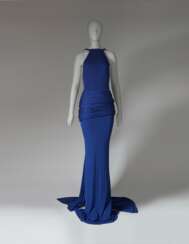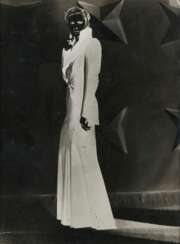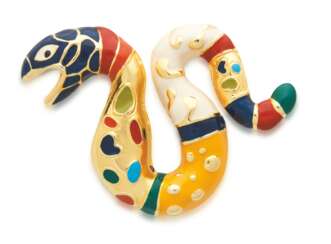
Women in art

Louise Joséphine Bourgeois was a French-American artist. Although she is best known for her large-scale sculpture and installation art, Bourgeois was also a prolific painter and printmaker. She explored a variety of themes over the course of her long career including domesticity and the family, sexuality and the body, as well as death and the unconscious. These themes connect to events from her childhood which she considered to be a therapeutic process. Although Bourgeois exhibited with the Abstract Expressionists and her work has much in common with Surrealism and Feminist art, she was not formally affiliated with a particular artistic movement.

Anne Vallayer-Coster was a renowned French artist, celebrated for her exceptional still-life paintings that captivated 18th-century art enthusiasts, including the French Queen Marie Antoinette. Born into an artistic family in 1744, Vallayer-Coster's talent was evident early on, leading to her unanimous election into the prestigious Académie Royale at just 26 years old. Her works, characterized by their vibrant color, meticulous detail, and textural precision, often depicted bowls of fruit, game, shells, and flowers, showcasing the opulence of French aristocracy before the Revolution.
Vallayer-Coster's career was notable not only for her artistic achievements but also for her ability to navigate the male-dominated art world of her time. Despite the societal constraints on women artists, she gained the patronage of influential figures like Marie Antoinette and was one of the few women admitted to the Royal Academy of Painting and Sculpture. Her work received critical acclaim at the Salon, where she exhibited regularly from 1771 until 1817, and her still-lifes were praised for their sensuality, illusionistic perfection, and the rich, indulgent luxury they portrayed.
One of Vallayer-Coster's most ambitious works, Still Life with Flowers in an Alabaster Vase and Fruit (1783), exemplifies her unparalleled skill in capturing the soft textures of flowers and their harmonious arrangement. This masterpiece was hailed as such at the Salon of 1783 and is considered by Vallayer-Coster herself as her finest painting. Lost for nearly two centuries, it was recently rediscovered in an almost pristine state and is now part of the National Gallery of Art's collection, highlighting Vallayer-Coster's significant contributions to European art history.
Throughout her career, Vallayer-Coster produced more than 120 still lifes, always with a distinctive brilliance in color, earning her a place among the elite artists of her time. Despite facing challenges during the French Revolution due to her close association with the monarchy, she continued to exhibit her work and contribute to the art world until her death in 1818.
For collectors and experts in art and antiques, Anne Vallayer-Coster's legacy is a testament to her skill, resilience, and the impact of her work on the history of art. To stay updated on new product sales and auction events related to Anne Vallayer-Coster, sign up for updates that focus solely on this exceptional artist's contributions to the art world.

Lavinia Fontana was a Bolognese Mannerist painter active in Bologna and Rome. She is best known for her successful portraiture, but also worked in the genres of mythology and religious painting. She was trained by her father Prospero Fontana who was a teacher at the School of Bologna. She is regarded as the first female career artist in Western Europe as she relied on commissions for her income. Her family relied on her career as a painter, and her husband served as her agent and raised their 11 children. She was perhaps the first woman artist to paint female nudes, but this is a topic of controversy among art historians.

Tamara Łempicka (born Tamara Rosalia Gurwik-Górska), better known as Tamara de Lempicka, was a Polish painter who spent her working life in France and the United States. She is best known for her polished Art Deco portraits of aristocrats and the wealthy, and for her highly stylized paintings of nudes.

Tamara Łempicka (born Tamara Rosalia Gurwik-Górska), better known as Tamara de Lempicka, was a Polish painter who spent her working life in France and the United States. She is best known for her polished Art Deco portraits of aristocrats and the wealthy, and for her highly stylized paintings of nudes.

Meret Oppenheim was a Swiss artist. She is best known for her surrealist sculptures and objects, which often featured everyday objects that had been transformed through unexpected combinations and juxtapositions.
Oppenheim was part of the surrealist movement, which aimed to liberate the unconscious mind and challenge traditional ideas about art and reality. Her most famous work is "Object" (1936), a fur-covered teacup, saucer, and spoon that has become an iconic symbol of surrealist art.
Oppenheim's work often explored themes of gender and sexuality, and she was interested in the idea of transforming everyday objects into works of art. She frequently used materials such as fur, leather, and feathers in her work, which added a tactile element to her sculptures.
Oppenheim was also an accomplished painter and photographer, and her work often incorporated elements of these mediums as well. She was a trailblazer for women in the art world and was one of the few female artists to achieve recognition during the male-dominated surrealist movement.
Today, Oppenheim's work is celebrated for its wit, humor, and subversive power, and she is considered one of the most important artists of the 20th century.

Meret Oppenheim was a Swiss artist. She is best known for her surrealist sculptures and objects, which often featured everyday objects that had been transformed through unexpected combinations and juxtapositions.
Oppenheim was part of the surrealist movement, which aimed to liberate the unconscious mind and challenge traditional ideas about art and reality. Her most famous work is "Object" (1936), a fur-covered teacup, saucer, and spoon that has become an iconic symbol of surrealist art.
Oppenheim's work often explored themes of gender and sexuality, and she was interested in the idea of transforming everyday objects into works of art. She frequently used materials such as fur, leather, and feathers in her work, which added a tactile element to her sculptures.
Oppenheim was also an accomplished painter and photographer, and her work often incorporated elements of these mediums as well. She was a trailblazer for women in the art world and was one of the few female artists to achieve recognition during the male-dominated surrealist movement.
Today, Oppenheim's work is celebrated for its wit, humor, and subversive power, and she is considered one of the most important artists of the 20th century.

Meret Oppenheim was a Swiss artist. She is best known for her surrealist sculptures and objects, which often featured everyday objects that had been transformed through unexpected combinations and juxtapositions.
Oppenheim was part of the surrealist movement, which aimed to liberate the unconscious mind and challenge traditional ideas about art and reality. Her most famous work is "Object" (1936), a fur-covered teacup, saucer, and spoon that has become an iconic symbol of surrealist art.
Oppenheim's work often explored themes of gender and sexuality, and she was interested in the idea of transforming everyday objects into works of art. She frequently used materials such as fur, leather, and feathers in her work, which added a tactile element to her sculptures.
Oppenheim was also an accomplished painter and photographer, and her work often incorporated elements of these mediums as well. She was a trailblazer for women in the art world and was one of the few female artists to achieve recognition during the male-dominated surrealist movement.
Today, Oppenheim's work is celebrated for its wit, humor, and subversive power, and she is considered one of the most important artists of the 20th century.












































![[Gabrielle Chanel (Saumur 1883–1971 Paris)]](/assets/image/picture_1522854/15a83/15997f747ed07a379e08dfaea95ca28b1623794400jpg__fix_374_244.jpeg)
![[Gabrielle Chanel (Saumur 1883–1971 Paris)]](https://veryimportantlot.com/assets/image/picture_1522854/15a83/15997f747ed07a379e08dfaea95ca28b1623794400jpg__fix_374_244.jpeg)














